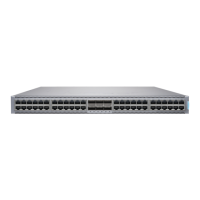transmission. Passive media components such as cables, cable splices, and connectors cause
aenuaon. Although aenuaon is signicantly lower for opcal ber than for other media, it sll
occurs in both mulmode and single-mode transmissions. An ecient opcal data link must transmit
enough light to overcome aenuaon.
Dispersion
is the spreading of the signal over me. The following two types of dispersion can aect
signal transmission through an opcal data link:
• Chromac dispersion, which is caused by the dierent speeds of light rays.
• Modal dispersion, which is caused by the dierent propagaon modes in the ber.
For mulmode transmission, modal dispersion usually limits the maximum bit rate and link length.
(Chromac dispersion or aentuaon does not usually limit the maximum bit rate or link length.) For
single-mode transmission, modal dispersion is not a factor. However, at higher bit rates and over longer
distances, chromac dispersion limits the maximum link length.
An ecient opcal data link must have enough light to exceed the minimum power that the receiver
requires to operate within its specicaons. In addion, the total dispersion must be within the limits
specied for the type of link in the Telcordia Technologies document GR-253-CORE (Secon 4.3) and
Internaonal Telecommunicaons Union (ITU) document G.957.
When chromac dispersion is at the maximum allowed, its eect can be considered as a power penalty
in the power budget. The opcal power budget must allow for the sum of component aenuaon,
power penales (including those from dispersion), and a safety margin for unexpected losses.
Calculate the Fiber-Opc Cable Power Budget for an MX10004 Router
Calculate the link's power budget when planning ber-opc cable layout and distances to ensure that
ber-opc connecons have sucient power for correct operaon. The power budget is the maximum
amount of power the link can transmit. When you calculate the power budget, you use a worst-case
analysis to provide a margin of error, even though the parts of a congured system don’t operate at the
worst-case levels. We cannot use the phrase "all parts . . . don't operate." You can write "none of the
parts operate," however.
To calculate the worst-case esmate for the ber-opc cable power budget (P
B
) for the link:
1. Determine values for the link's minimum transmier power (P
T
) and minimum receiver sensivity
(P
R
). For example, in the following example, we measure (P
T
) and (P
R
) in decibels per milliwa (dBm):
P
T
= –15 dBm
P
R
= –28 dBm
98

